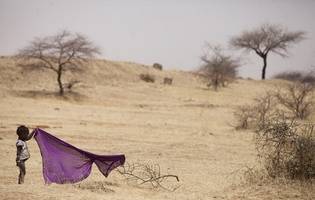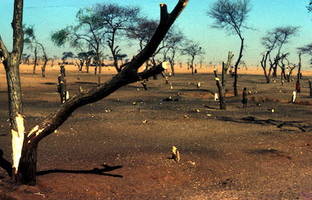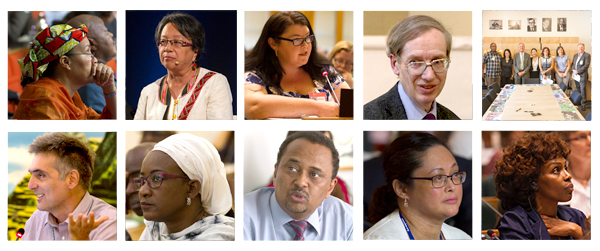Tuesday 20 July
Forests and Climate Change

- @FAO/Giulio Napolitano Tera, Niger. A child plays as women prepare the fields for the next rainy season. Action Against Desertification.
Forests feature prominently in the Paris Agreement adopted at COP21 of UNFCCC in Paris in December 2015. The Agreement encourages Parties to implement REDD+ and joint mitigation and adaptation approaches, while incentivizing non-carbon benefits. It also calls for enhanced action on adaptation. Forests are central to both mitigation and adaption strategies, as reflected in their inclusion in a large majority of countries’ Intended Nationally Determined Contributions which underpin the Agreement.
The Paris Agreement has also provided impetus to FAO's work on climate change, which is a priority area of the Organization. FAO is currently developing a climate change strategy, which will embody FAO's corporate approach to its work on climate change, thereby strengthening the impact of its delivery to member countries and to international processes.The draft is being discussed by COFO, as well as FAO's other technical committees.
The strategy, cutting across FAO's five Strategic Priorities, will integrate regional and country priorities and build on the recommendations of several key related internal and external processes. Following its review by FAO's technical committees, it will be reviewed by the FAO Council in late 2016. A corresponding action plan will be developed to strengthen the impact of delivery, bolstered by FAO's comparative advantages at the global, regional and national levels.
COFO members have been informed of and made recommendations on FAO's work on forests and climate change carried out by the Forestry Department.
Read more in COFO23 document COFO/2016/6.1 Rev.1.

- ©FAO/Giulio Napolitano.
Women taking a rest at the end of the morning's work in the field in Djibo, Burkina Faso. The Action Against Desertification project promotes sustainable land management and restores drylands in Africa, the Caribbean and the Pacific.
Assisting the world's two billion drylands people: new groundbreaking FAO report
Global drylands contain 27 percent of the global forest area, but following decades of progressive loss and degradation, their ability to support an estimated two billion people plus animals that depend on them is being severely compromised. Climate change is also making this precarious situation worse and thus the need for remedial action all the more urgent.
Information on which to base dryland policies and action has also been largely absent, but a new groundbreaking FAO report to be released later in the year will fill a significant gap, by providing statistically based knowledge on trees, forests and land use in drylands.
Preliminary findings, from freely available satellite imagery from Google Earth Engine and Bing maps, combined with knowledge from over 200 experts on land and land use in specific dryland regions around the world, indicate that an estimated 1.1 billion ha of forests are in drylands and 13.5 billion trees grow outside forests. Thus drylands, as a crucial source of food and livelihoods, are able to significantly increase the resilience of millions of peoples.
- Without solid knowledge of drylands, we don't understand how the planet functions - Alan Grainger, University of Leeds
- Drylands are no longer a mystery - Danilo Mollicone, FAO
Read more in the FAO press release and view the preliminary findings of the FAO report on Trees, forests and land use in drylands: the first global assessment.
Forests and woodfuel in emergency situations

- @FAO/F. McDougall. Trees in central Sudan have been cut off or left denuded by refugees from a nearby camp in search of wood and fodder.
By the end of 2015, 65.3 million people had been forcibly displaced from their homes, often being forced to live in temporary settlements in and around forests. With minimal access to other energy sources, many resort to using biomass, particularly woodfuel and charcoal, to cook food and boil water for bathing or to drink, or to heat their shelters.
Large influxes of displaced people can have significant detrimental impacts on surrounding forests, with the refugees themselves at increased risk of malnutrition and poor health. Thus to help maintain sustainable forest resources management, energy access and people’s resilience, FAO and the UN High Commissioner for Refugees have produced a technical handbook with recently developed methodology to assess woodfuel supply and demand in displacement settings.
Read more about the WFW5 side event Forests and woodfuel in emergency situations and read the new publication Assessing woodfuel supply and demand in displacement settings.
Funding opportunities for forests after the Paris Agreement
A key provision of the Paris Agreement is on finance flows to favour low greenhouse gas emissions and climate-resilient development, with a related 2009 UNFCCC agreed goal committing contracting parties to mobilize at least US$ 100 billion annually. In both climate-change mitigation and adaptation, the multiple roles and benefits of sustainably managed forests, that go beyond carbon, are clearly recognized.
A major consideration is that, if global goals are to be attained and sustainably maintained, countries will need access to adequate and predictable financing. But as developing countries in particular shift to prioritizing climate actions in their national plans and budget spending, they are steering away from low-level and uncertain voluntary carbon markets and towards higher level and more strategic and targeted funding.
However, the proliferation and fragmentation of such options makes the choice of which form of financing to leverage an uneasy one for many countries. FAO’s proposed support would thus help them navigate the options as well as have recourse to the Organization's global facilities and expertise.
Read more in the COFO23 document COFO/2016/6.2 and in the related FAO Forestry paper 174 towards effective national forest funds
Forest-related indicators and monitoring of the SDGs
The 169 targets and 231 indicators of the 17 Sustainable Development Goals (SDGs) have been designed to guide and measure progress towards sustainable development until 2030. Forests feature prominently throughout the Goals because of the breadth of social, economic and environmental benefits they provide.
Forest data will contribute directly to the monitoring of progress of 12 SDG targets and 13 forest-related indicators. The aggregates for global reporting will be provided by countries, requiring national efforts to ensure the availability and quality of data. Countries might also create national indicators in addition to global ones, according to their own priorities and needs.
Thus, as recognized by the Interagency and High-Level Expert Group on SDG Indicators, the primary need in many developing countries will be for support in strengthening capacities in statistical data collection and compilation. FAO, with custodianship of three forest-related indicators (15.1.1, 15.2.1, 15.4.2) and through its country support to data-collection exercises using existing methods and modern technologies, has an important role. This includes collaborating with partners to reduce the reporting burden on countries.
Read more in COFO Document COFO/2016/5.2
Costa Rican composer performs to highlight threats to forest ecosystems

- ©FAO/Roberto Cenciarelli
Costa Rican pianist and composer Manuel Obregón performed a unique experimental concert in a bid to increase awareness about the threats to forest ecosystems posed by climate change and unsustainable logging. For his performance Simbiosis-Piano and Rainforest, Mr Obregon spent 36 hours composing and recording the sounds and images of native flora and fauna in the cloud forest of Monteverde.
Read more in the FAO Forestry news story about the concert performance of Mr Manuel Obregón, held on 19 July during World Forest Week 5. Also view the recording of the concert here.
COFO 23 Champion Trees photo competition: the public jury's out
Six photos are competing on FAO’s Facebook page in a public vote for the winner of the #COFO23 #ChampionTrees photo contest, which is challenging people to send in photos of extraordinary trees they know. The aim is to raise awareness about the pressure trees are subject to as a result of changes in the uses of land, or from the effects of climate change such as increased weather events, forest fires and pests.
Read more in the FAO Forestry news story on the COFO 23 Champion Trees photo contest.

